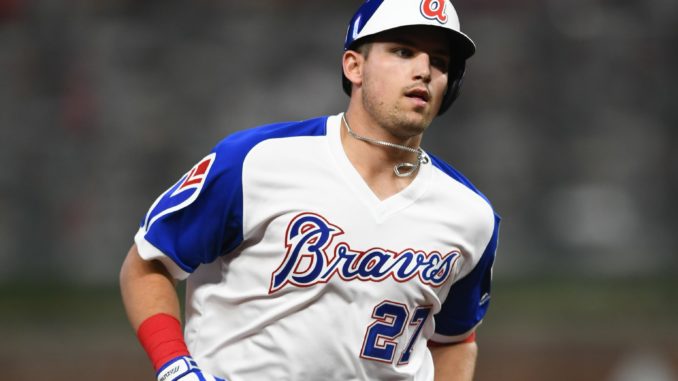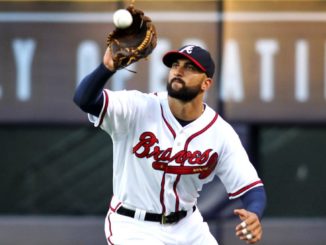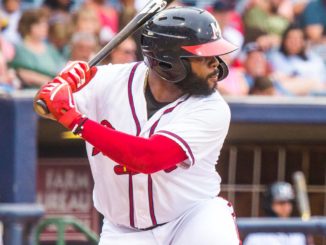
Welcome to our annual look at the overall system depth at each position. If you believe in WAR as a good measure of overall value, then the Braves finished dead last in baseball in 2020 at the third base position. While there were reports that the Braves were flirting with making a move to address the position this offseason, at least for now the Braves will look to their “Third Baseman of the Future” to continue his maturation at the big league level and become the Third Baseman of the Present.
First Base | Second Base | Shortstop | Catcher | Left Field | Centerfield | Right Field | Starting Pitcher | Relief Pitcher
 ATLANTA BRAVES
ATLANTA BRAVES
STARTER: Austin Riley
For now Austin Riley is penciled in to resume third base duties. Riley was a compensation-round draft pick in 2015 (a pick gained from San Diego in the Craig Kimbrel trade). Riley quickly established himself as a top power prospect in the lower minor leagues, though some pundits and scouts were concerned about his bat speed. Riley worked hard to improve this aspect of his game, and as he rose to the high-A and AA levels in 2017 he largely put those concerns behind him. Riley dominated AA and AAA in 2018, but an ACL tear slowed him down. With Josh Donaldson installed at third base in 2019 and Riley raking in AAA, the team called him up to play him in left field. He took the major leagues by storm, hitting .295/.336/.616 with 10 home runs in his first month worth of games. Major league pitchers adjusted, as they always do, and Riley couldn’t adjust back, flailing against big league breaking balls. He then was slowed by a partially torn knee ligament. He won the third base job in spring/summer camp in 2020, but started out uncharacteristically shaky in the field, especially on throws. This stabilized over time; at the plate it was clear that Riley was looking for breaking balls to hit opposite field and mostly doing well against the pitch that plagued him in 2019, which helped drop his strikeout rate from an unmanageable 36% in 2019 down to a reasonable 24% in 2020. Unfortunately, this too often made him late on the fastball, giving rise to the old “slow bat speed” takes from earlier in his minor league career.
Baseball is, as the cliché goes, a game of adjustments. The good news for Riley is that his entire pro career has shown that he can successfully adjust. What’s painful so far in his career is the length of time to show improvement once it’s clear that pitchers have found a new way to get him out. Riley will need to at some point stop reacting to pitchers scouting reports and be able to put together quality at-bats no matter what the pitcher is doing to him. As a potential big-power bat that also plays quality defense at a skill position and is still only 23 years old, Riley still has the ability to be a major contributor; it remains to be seen how long the Braves will continue to be patient with him as he matures.
Back-up: The Braves signed veteran Jake Lamb early in spring training to a major league deal, and he will be in line to back up at third base and be the primary left-handed bat off the bench, though he could also potentially step into the starters role if Riley should stumble. Ehire Adrianza if more of a defensive option as well and could play any infield position. Incumbents Johan Camargo and Pablo Sandoval will also be looking to keep major league roster spot.
Upper-Level Minor Leaguers
IF Johan Camargo
Projected Level: AAA Gwinnett
A starter at third base for Atlanta in 2018 and a key reserve the last two seasons, Camargo has a strong shot at a major league bench role, but with Sandoval and Adrianza onboard on minor league deals and Camargo still with an option, the Braves could instead stash Camargo at AAA until needed. Camargo has been sent down once each of the last two seasons, so it’s clear the Braves do not necessarily see him as an indispensable piece of the club. Camargo has played this winter and should be in good form to start camp and he hit a key home run to help the Dominican Republic claim the Caribbean Series crown.
Back-up: Gwinnett’s infield will likely have several options for third base, with or without Camargo on the roster. Riley Unroe and Sean Kazmar Jr. also have experience at the position.
3B/1B CJ Alexander
Projected Level: AA Mississippi
Alexander’s first pro season after being drafted in the 20th round of the 2018 draft went about as well as anyone could hope. Alexander dominated at both rookie league levels before getting a double promotion to high-A Florida to finish out the season. After getting a major league spring training invite in 2019, it was clear the Braves were impressed with what they saw from Alexander, but an elbow injury suffered in the spring first pushed Alexander to first base and then the surgeon’s table. Alexander returned at mid-season, but couldn’t get back on track at either Florida or Mississippi before having to end the season early after injuring himself diving into the stands after a foul ball.
When healthy, Alexander showed a better than expected hit tool and good raw power. Alexander had a good arm at third prior to the elbow surgery, but it’s unclear how it is now. The Braves indicated that they were still on the CJ Alexander train when they give him another major league spring training invite for 2021.
Back-up: As discussed in the previous looks at infield system depth, Brett Langhorne, Kevin Josephina, and possibly Riley Delgado all could start the season at this level and each has experience at third base.
Lower-Level Minor Leaguers
 3B/SS Vaughn Grissom
3B/SS Vaughn Grissom
Projected Level: A+ Rome
It’s unclear where Grissom will start, both in terms of level and position, but my guess is at high-A Rome and at third base. There are two facts that inform this guess: 1) he was playing at third base at instructionals and 2) after a summer at the alternate training site he’s probably advanced beyond low-A. That said, he very well could be Augusta’s shortstop with the team telling him that his play will determine where he ends up. In any case, Grissom is one of the more exciting bats in the lower minors despite only recently having turned 20 years old with potential plus hit and power.
Back-up: Braulio Vasquez would most likely back-up third base at this level, regardless of who actually ends up with the starting assignment.
3B Darling Florentino
Projected Level: A Augusta
Florentino was the Opening Day starting third baseman for low-A Rome in 2019, a surprising and ambitious assignment for a 17-year-old. Florentino flashed the power that makes him an interesting prospect, but also showed how overmatched he was at the placement by batting .198/.239/.310 before mercifully being sent back to the rookie leagues for the rest of the season. Now at the ripe old age of 19 years old, Florentino could be in line for another shot at third base, this time for low-A Augusta where he will still be young relative to the league.
Back-up: Garrett Saunders can play all over the infield, and third base is no exception.
Short-Season Minor Leaguers
3B Cody Birdsong
If the Braves decide Florentino still needs time in extended spring training, Birdsong may be the choice to head up to Augusta instead. A 32nd-round pick in 2019, Birdsong was the primary third baseman for advanced-rookie Danville in 2019, hitting .234/.278/.340 and showing a capable glove.
3B Cade Bunnell
If neither Florentino nor Birdsong is viewed as a good option, the Braves could also possibly turn to Bunnell, who has already beaten the odds by staying rostered through the pandemic despite being a 40th-round pick. Bunnell is 23 years old and could also be a utility infield option.
3B Jose Dilone
The 20-year-old Dilone had a solid .267/.371/.307 batting line with 18 stolen bases in his pro debut with the DSL Braves in 2019 and could be yet another Augusta option.
Third Base Depth Chart
- Austin Riley
- Jake Lamb
- Ehire Adrianza
- Johan Camargo
- Riley Unroe
- Sean Kazmar Jr.
- CJ Alexander
- Kevin Josephina
- Brett Langhorne
- Vaughn Grissom
- Braulio Vasquez
- Darling Florentino
- Garrett Saunders
- Cody Birdsong
- Cade Bunnell
- Jose Dilone







Leave a Reply